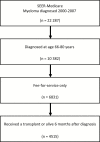The real world effectiveness of hematopoietic transplant among elderly individuals with multiple myeloma
- PMID: 26023094
- PMCID: PMC4554189
- DOI: 10.1093/jnci/djv139
The real world effectiveness of hematopoietic transplant among elderly individuals with multiple myeloma
Abstract
Background: Hematopoietic stem cell transplant (HSCT) is the preferred treatment for young patients with multiple myeloma (MM), but for older adults there is limited evidence on its effectiveness from clinical trials.
Methods: We used the Surveillance, Epidemiology, and End Results (SEER)-Medicare database to identify individuals age 66 years and older with multiple myeloma (MM) who were diagnosed between 2000 and 2007. We used traditional multivariable analysis, propensity score-based analysis, coarsened exact matching, and an instrumental variable analysis to compare survival for individuals who did or did not receive an hematopoietic stem cell transplant. Survival was measured by Cox proportional hazard models. All statistical tests were two-sided.
Results: Patients with MM receiving an HSCT were more likely to be white, married, younger, and have fewer comorbidities. Results from all analytic techniques consistently showed that HSCT statistically significantly improved survival, with hazard ratios (HRs) ranging from 0.531 to 0.608 (traditional multivariable analysis: HR = 0.582, 95% confidence interval [CI] = 0.49 to 0.69; propensity score analysis: HR = 0.572, 95% CI = 0.46 to 0.72; coarsened exact matching: HR = 0.608, 95% CI = 0.49 to 0.76; instrumental variable analysis: HR = 0.531, 95% CI = 0.36 to 0.78, all P values ≤ .001).
Conclusions: Overall survival has increased among patients with MM receiving HSCT. This finding was consistent across statistical methods, indicating robustness of our findings.
© The Author 2015. Published by Oxford University Press. All rights reserved. For Permissions, please e-mail: journals.permissions@oup.com.
Figures


References
-
- Child JA, Morgan GJ, Davies FE, et al. High-dose chemotherapy with hematopoietic stem-cell rescue for multiple myeloma. New Engl J Med. 2003;348 (19):1875–1883. - PubMed
-
- Attal M, Harousseau JL, Stoppa AM, et al. A prospective, randomized trial of autologous bone marrow transplantation and chemotherapy in multiple myeloma. Intergroupe Francais du Myelome. New Engl J Med. 1996;335 (2):91–97. - PubMed
-
- Bird JM, Owen RG, D’Sa S, et al. Guidelines for the diagnosis and management of multiple myeloma 2011. Br J Haematol. 2011;154 (1):32–75. - PubMed
-
- McCarthy PL, Jr, Hahn T, Hassebroek A, et al. Trends in use of and survival after autologous hematopoietic cell transplantation in North America, 1995–2005: significant improvement in survival for lymphoma and myeloma during a period of increasing recipient age. Biol Blood Marrow Transplant. 2013;19 (7):1116–1123. - PMC - PubMed
Publication types
MeSH terms
Grants and funding
LinkOut - more resources
Full Text Sources
Other Literature Sources
Medical

